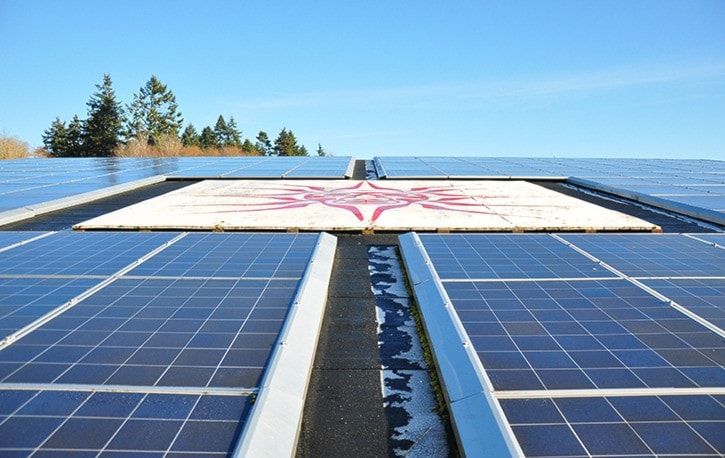For millennium, humanity looked towards the sun to harvest its power, whether it was for food, navigation or time, but if the last several decades are any example, the focus is towards something even bigger: electrical power.
Last week, T’Sou-ke Nation Chief Gordon Planes, along with Juan de Fuca MLA John Horgan and Alberni-Pacific Rim MLA Scott Fraser demonstrated the potential of several solar arrays on roofs of T’Sou-ke buildings that feed electricity back into the grid.
The solar project, which came online six years ago, is an ongoing demonstration of renewable and off-grid generation of electrical power, which, as recent technology shows, will only get more efficient, less expensive and more compact to install.
The project also led to a feed-in-tariff agreement between the T’Sou-ke Nation and B.C. Hydro, which, instead of electrical bills coming in, the T’Sou-ke bills B.C. Hydro for the generated power. As of October, the electrical bill for the building was $6,222 credit from B.C. Hydro.
It’s not just a marketing gimmick either. In the administration building everything, from the heaters to the lights, computers and coffee machines, are all powered by solar panels installed on the roof. Energy from the array is also distributed to the fisheries and treaty buildings.
Planes said this is just the tip of the renewable energy technology available out there, adding now is the time to start investing into it.
“If we’re not on top of it, then we’ll lose out,” Planes said, adding that if no one is trying this technology, conventional means of power such as hydro, oil and coal will remain in power for generations to come.
Planes laughed when the comparison was even mentioned.
“What do you get when you get a solar spill as opposed to an oil spill? You get a very nice day.”
The facility also includes a charging station for electric cars, which can take as little as two hours to charge a car, all for free. The station is also integrated in an app network that tells electric vehicle drivers on their cell phones that there is a charging station here.
“The goal for the chief and the T’Sou-ke Nation is to demonstrate to British Columbians that innovation is happening right now, not sometime in the future,” said Horgan, who recently put forward a plan for renewable energy, for conservation and for keeping B.C. Hydro rates low.
Planes isn’t stopping for breath either. He and the T’Sou-ke council is looking towards even more efficient solar technology, such as experimenting with microfibre panels that weigh close to nothing and can be slapped onto any surface with instant potential to generate electricity.
There’s also plans to extend the creation of “solar hot water” among the band’s buildings and residents, some of whom already use the technology now.
Horgan agreed with the idea, noting the cost of solar technology dropped by 80 per cent in recent years, making it far more affordable. In contrast, he poked at the provincial government’s current proposal to invest in existing infrastructure as being simply out of date.
“It’s why spending $9 billion on 1950s technology just doesn’t make any sense,” he said. “If you have $9 billion to spend on energy conservation and retrofitting, spend it on new technology.”
Current storage technology could be in their favor as well, which allows solar array systems to retain significantly more electricity in their batteries during nighttime than ever before.
Even when the project began in 2009, there were no high expectations the results would be so successful.
“When we embarked on this venture, we didn’t think that we would get cheques from B.C. Hydro every month, but we have,” Planes said. “Imagine what we could do as citizens of B.C. if we took this technology and put it toward the future.”
At this point, the T’Sou-ke’s solar setup is what’s called “net zero.”
“That means that during the summer, you sell to B.C. Hydro, they store it, then in the winter, you buy it back, but you’ve designed it to be zero over the whole year,” Planes said.
